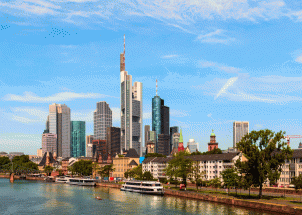New progress for the European office market
The economic recovery continues in the Eurozone. Despite a slowdown at mid-year, GDP maintained a stable pace of growth in 2016 with 1.7% on average, notably thanks to investment expenditure and foreign trade that recovered during summer. Eurozone activity appears to have been neither buoyed nor punctured by recent geopolitical events. It should enjoy growth close to 1.5 % in 2017, a slight decline on 2016 due to political uncertainties at national level and some less favourable economic fundamentals (such as raw materials, inflation, oil prices and interest rates). Job creation increased emphatically in the Eurozone over the last year (+1.2%). The unemployment rate remains very high on average (9.8% of the labour force) yet keeps on contracting, suggesting that the pre-crisis level will be reached in early 2020.
Office take-up in Western Europe increased in 2016 (+3%) for the third year in a row even with a slower Q4. With 8.3 million m² transacted, 2016 has been the best performance since 2007. However, Central London, the second largest European market, dropped by 17% as many occupiers halted expansion plans after the United Kingdom’s vote to leave the European Union. Southern European markets such as Milan (-15%) and Madrid (-11%) fell back after an exceptional 2015. In contrast, strong national economic fundamentals resulted in German markets reaching a new all-time high with 2.7 million m² transacted in the 4 main markets, with Berlin ahead (+3%), followed by Munich (+5%), Frankfurt (+26%) and Hamburg (+3%). The Central Paris office market finished the year 9% up on 2015, driven by transactions over 5,000 m² (+23%). Brussels (+46%) and Vienna (+43%) performed particularly well in 2016 after a weak 2015, while the Amsterdam office market (+14%) recorded its best level of take-up since 2008.
The average vacancy rate of the 14 main European markets kept on shrinking in 2016 and hit its lowest point ever at 8.0%, losing 50 basis points compared to the end of 2015. The trend is led by German markets. Considering the explosion of the take-up these few last years and the lack of deliveries, vacancy rates reached new lows with 2.8% in Berlin, 4.2% in Munich and 5.9% in Hamburg. Central London retained one of the lowest vacancy rates in Europe (5.8%), but started to grow prompted by a drop in take-up combined with some new supply (+140 bps compared to the end of 2015). A higher aggregate vacancy in some other markets is hiding very low vacancy rates in the most sought-after sectors such as Paris CBD (4.0%), Brussels CBD (4.8%) or Milan CBD (3.9%). In view of this market situation combining growing occupiers demand on the one hand and availability reduction on the other hand, prime rents rose in most of the markets such as Berlin (+14%), Amsterdam (+5%), Brussels, Luxembourg or Madrid (+4%). Rental growth mirrors the trends across most prime locations.



